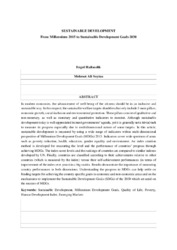Sustainable development from millennium 2015 to sustainable development goals 2030
| dc.contributor.author | Halisçelik, E. | |
| dc.contributor.author | Soytaş, Mehmet Ali | |
| dc.date.accessioned | 2019-02-05T07:29:09Z | |
| dc.date.available | 2019-02-05T07:29:09Z | |
| dc.date.issued | 2019-07 | |
| dc.identifier.issn | 0968-0802 | |
| dc.identifier.uri | http://hdl.handle.net/10679/6139 | |
| dc.identifier.uri | https://onlinelibrary.wiley.com/doi/full/10.1002/sd.1921 | |
| dc.description.abstract | In modern economies, the advancement of well‐being of the citizens should be in an inclusive and sustainable way. In this respect, the sustainable welfare targets should exclusively include three main pillars: economic growth, social inclusion, and environmental protection. These pillars consist of qualitative and nonmonetary, as well as monetary and quantitative indicators to monitor. Although sustainable development today is well‐appreciated in most governments' agenda, yet it is generally not a trivial task to measure its progress especially due to multidimensional nature of some targets. In this article, sustainable development is measured by using a wide range of indicators within multidimensional perspective of Millennium Development Goals (MDGs) 2015. Indicators cover wide spectrum of areas such as poverty reduction, health, education, gender equality, and environment. An index creation method is developed for measuring the level and the performance of countries' progress through achieving MDGs. The index score levels and the rankings of countries are compared with similar indexes developed by United Nations. Finally, countries are classified according to their achievements relative to other countries (which is measured by the index) versus their self‐achievement performances (in terms of improvement of the index over years) in a big matrix. Results demonstrate the importance of measuring country performances in both dimensions. Understanding the progress in MDGs can help settle on binding targets for achieving the country specific goals in economic and noneconomic areas and on the mechanisms to implement the Sustainable Development Goals (SDGs) of the 2030, which set amid on the success of MDGs. | en_US |
| dc.language.iso | eng | en_US |
| dc.publisher | Wiley | en_US |
| dc.relation.ispartof | Sustainable Development | en_US |
| dc.rights | openAccess | |
| dc.title | Sustainable development from millennium 2015 to sustainable development goals 2030 | en_US |
| dc.type | Article | en_US |
| dc.description.version | Post print | en_US |
| dc.peerreviewed | yes | en_US |
| dc.publicationstatus | Published | en_US |
| dc.contributor.department | Özyeğin University | |
| dc.contributor.authorID | (ORCID 0000-0001-5839-6069 & YÖK ID 231352) Soytaş, Mehmet | |
| dc.contributor.ozuauthor | Soytaş, Mehmet Ali | |
| dc.identifier.volume | 27 | |
| dc.identifier.issue | 4 | |
| dc.identifier.startpage | 572 | en_US |
| dc.identifier.endpage | 545 | en_US |
| dc.identifier.wos | WOS:000481442100001 | |
| dc.identifier.doi | 10.1002/sd.1921 | en_US |
| dc.subject.keywords | Emerging markets | en_US |
| dc.subject.keywords | Human development index | en_US |
| dc.subject.keywords | Millennium development goals | en_US |
| dc.subject.keywords | Sustainable development | en_US |
| dc.identifier.scopus | SCOPUS:2-s2.0-85060521751 | |
| dc.contributor.authorMale | 1 | |
| dc.relation.publicationcategory | Article - International Refereed Journal - Institutional Academic Staff |
Files in this item
This item appears in the following Collection(s)
Share this page



